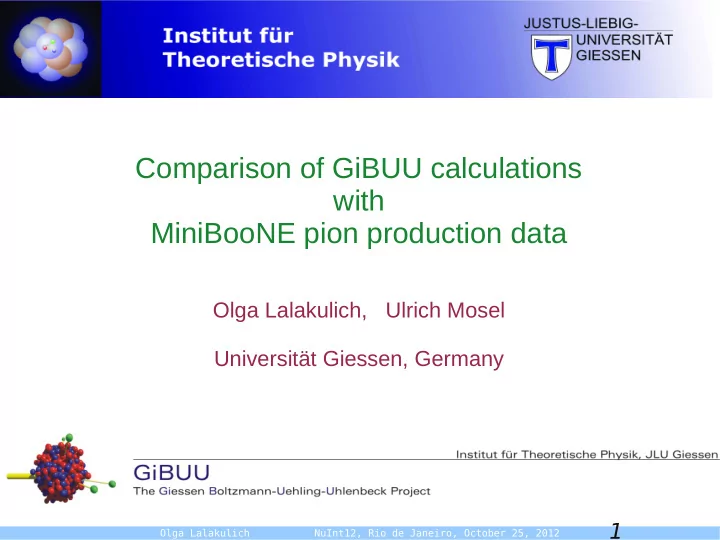

Comparison of GiBUU calculations with MiniBooNE pion production data Olga Lalakulich, Ulrich Mosel Universität Giessen, Germany 1 Olga Lalakulich NuInt12, Rio de Janeiro, October 25, 2012
GiBUU model – the semiclassical transport model in couple channels – simulates the transport of hadrons through nuclear matter in space and time GiBUU describes several reactions in resonance and high energy regions, is extensively checked against experimental data for A, A, e - A, A Aim: many reactions with one microscopic model Open source code: http:/gibuu.physik.uni-giessen.de/GuBUU 2 Olga Lalakulich NuInt12, Rio de Janeiro, October 25, 2012
Primary interactions El-m couplings are known for 13 or 19 PDG 3* and 4* Input: parametrization of the elementary xsec 3 Olga Lalakulich NuInt12, Rio de Janeiro, October 25, 2012
Input: Resonances Vector form factors: related to el-m for factors, those to helicity amplitudes helicity amplitudes are from MAID parameterization (MAID, Drechsel EPJA 34: Mainz state-of-the art unitary isobar model for pion photo- and electroproduction on the nucleon; based on >70000 data points; it provides the resonance helicity amplitudes, from which el-m transition form factors are derived; ) Inclusive electron scattering on carbon Discreapancy is probably due to many-body: 50% in the dip region 10% at Delta peak 4 Olga Lalakulich NuInt12, Rio de Janeiro, October 25, 2012
Input: Resonances Axial form factors dipole ansatz (modified dipole for Delta), related via PCAC using neutrino data when possible Delta fitted to p π + data (ANL or BNL) Graczyk et al PRD80, Hernandez et al PRD81 : ANL and BNL are compatable w ithin errors and flux uncertainties. Joint fit of the data. GiBUU: consider ANL as lower bound and BNL as upper bound 5 Olga Lalakulich NuInt12, Rio de Janeiro, October 25, 2012
Input: 1-pion background Phenomenological ansatz Vector part fitted to MAID results Nonvector part = “axial + vector-axial interferece” is supposed to have the same functional form and then fitted to ANL/BNL data 1-pion bgr + higher RES +DIS 6 Olga Lalakulich NuInt12, Rio de Janeiro, October 25, 2012
Influence of FSI Photoproduction of neutral pions Krusche et al EPJA22 (2004) rechecked with the current version of GiBUU Competing processes for Delta: ∆ N → NN, ∆ NN → NNN ∆ → N Competing processes for pion: N → R, ω N, φ N, K, K 0 n ↔ ‒ p, 0 p ↔ + n 7 Olga Lalakulich NuInt12, Rio de Janeiro, October 25, 2012
Influence of medium modification Delta is collison broadened according to Oset-Salsedo (OS) model and thus contains some many-body effects Broadening of the Delta bring the curves down to the data Exponential time-development of Delta disappearence dN −Γ free t −Γ collisional t dt = e 8 Olga Lalakulich NuInt12, Rio de Janeiro, October 25, 2012
Medium modif. for neutrino reactions: Oset/Salsedo modification: Delta production – 5-8% 1-pion production -15-20% 0-pion production +20% due to increased ∆ N → NN All further results are with Oset modification of the Delta 9 Olga Lalakulich NuInt12, Rio de Janeiro, October 25, 2012
MiniBooNE: origin of 1-pion events Delta production and decay 1-pion background events QE events; outgoing proton rescattered N N N N N charge exchange pion rescattering + n 0 p 10 Olga Lalakulich NuInt12, Rio de Janeiro, October 25, 2012
Muon kinetic energy and angle The shape of the distributions is hardly sensitive to the FSI The only effect of FSI on muon observables: remove events in which the initially produced pion (or Delta) was later on reabsorbed bring in events in which the pion was produced only during FSI 11 Olga Lalakulich NuInt12, Rio de Janeiro, October 25, 2012
! Compare to previously reported results ! Experiment Charged pion data were averaged over the whole neutrino flux Neutral pion data were averaged over the flux from 0.5 to 2 GeV (which constitutes 68% of the whole flux) (which brings in some model dependence via energy reconstruction) Theory All our previously published/reported results for neutral pions were averaged over the whole flux, therefore they are too low. In the present talk all results are normalized as in experiment Many thanks to Sam Zeller and Robert Nelson for helpful communication 12 Olga Lalakulich NuInt12, Rio de Janeiro, October 25, 2012
Muon angle distributions Experimental point at 0.9-1 is lower than the previous one Physical effect? The range cos θ = 0.9 - 1 corresponds to θ = 0 ° - 25.8 ° Finer binning is needed Compare cos θ = 0 - 0.1 corresponds to θ = 84.3 ° - 90 ° 13 Olga Lalakulich NuInt12, Rio de Janeiro, October 25, 2012
Q 2 distributions Q 2 has to be reconstructed! Dependence on energy reconstruction 14 Olga Lalakulich NuInt12, Rio de Janeiro, October 25, 2012
Pion distributions FSI clearly change the shape of the distribution (similar to el-m) 15 Olga Lalakulich NuInt12, Rio de Janeiro, October 25, 2012
Predictions for π - Created nearly only during FSI Good test for pion dynamics Significantly less forward peaked than 1 π + and 1 π 0 20 times lower than 1 π + but should be visible in MiniBooNE 16 Olga Lalakulich NuInt12, Rio de Janeiro, October 25, 2012
Theory/data discrepancy? Using 10% flux uncertainty Many-body mechanism for pion production? For QE-like scattering ν NN → μ NN relevant above dip region Similarly ν NN → μ N ∆ should be relevant 300 MeV higher. A theoretical challenge to separate them from successive scattering in a transport description 17 Olga Lalakulich NuInt12, Rio de Janeiro, October 25, 2012
Conclusions All processes (QE, Delta, highRES, 1-pi bgr, DIS) contribute Strong dependence of theoretical results on elementary xsec Dependence of theoretical results on medium Delta properties New measurements on elementary targets (H,D) needed If BNL data describe the elementary xsec correctly, many-body effects could amount to 10-20% at most If ANL data describe the elementary xsec correctly, many-body effects could amount up to 40% 18 Olga Lalakulich NuInt12, Rio de Janeiro, October 25, 2012
Recommend
More recommend